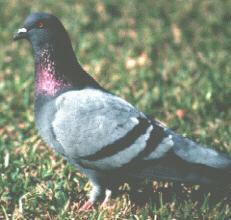Rock Pigeon (Columba livia)

TPWD ©
- Other Names
- Rock Dove
- Description
- The rock dove commonly is referred to as a pigeon. Patterns of blue to gray color vary from bird to bird. The wild rock dove generally has iridescent feathers on its head and neck. They also characteristically have two black bars across each wing, a white rump and a black band at the end of the bill.
- Life History
- The rock dove apparently was the first bird to be domesticated about 4500 B.C. Their outstanding homing capabilities, using the sun or the earth's magnetic field to return to their home lofts, gained for them a long and rich history of delivering messages, including during the times of Caesar and Napoleon.
Rock doves are all-around adaptable birds. They are able to exploit the many advantages that urban areas have to offer. They feed not only on grain, green leaves and invertebrates, but also on the goodies that people provide such as bread crumbs, popcorn, peanuts and cake. Individuals may sample several feeding sites, and they might even settle temporarily in an area should the availability of food be especially good.
Another advantage of the "city life" is the presence of building ledges, rafters, beams and bridged. Rock doves will build nests of sticks, twigs and grasses in these areas or in naturally occurring cliffs or caves. They prefer to breed and roost in groups since they are quite social.
Rock doves are paired monogamously for life. Both the male and the female guard the nest and incubate one or two white eggs, with several clutches per year. The incubation period lasts about 18 days.
The hatchlings are helpless, blind and downy. Both parents feed the young within two hours of their hatching with regurgitated "crop milk", a high fat, high protein, cheesy product produced by the adults. They are closely brooded for seven days by attentive parents. The young are able to fly 35 to 37 days after hatching. - Habitat
- Rock doves prefer cities, towns and rural areas and generally wherever humans are close by.
- Distribution
- The rock dove was first introduced into North America by the French at Port Royal, Nova Scotia in 1606. Rock doves have flourished in large cities throughout the world including North, Central and South America, the Hawaiian Islands and parts of the West Indies.They can be seen year-around throughout Texas.